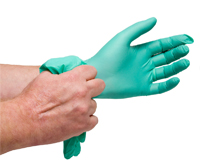
Latex allergy is a hypersensitivity to the naturally occurring protein found in rubber which may cause symptoms to arise. These symptoms may be as mild as skin irritations (contact dermatitis), hives, itchy eyes, and runny nose, to more severe occurrences such as asthma and life-threatening anaphylaxis.
The symptoms and signs associated with anaphylaxis include:
- Difficulty breathing
- Dizziness
- Confusion
- Wheezing
- Nausea
- Vomiting
- Rapid or weak pulse
- Loss of consciousness
- Shock
- Respiratory failure
- Circulatory failure
Many medical and dental supplies contain latex, including gloves, blood pressure cuffs, urinary catheters, dental dams and material used to fill root canals, as well as tourniquets and equipment for resuscitation. The tendency to develop allergies to latex appears to be an inherited trait, and as with other allergies, the more intense and frequent the exposure to latex, the more likely one is to develop an allergy to it. Healthcare workers have a greater chance (up to 10%) to develop a latex allergy due to their repeated exposure to rubber-based products. However, in recent years, there has been a move to decrease the addition of powder in these gloves (powder was used to ease the ability to put on the gloves and decrease perspiration of the hands within the latex gloves), and this appears to have decreased the occurrence amongst healthcare professionals of latex allergies.
Other groups at risk include those who have had various surgeries, especially those involving the nervous system and genitourinary tract system. Children with spina bifida also appear to have a higher occurrence of developing latex allergies.
If you have a known sensitivity or allergy to latex or any related items, please notify our office. Non-latex substitutes can be found for all of the latex-containing items that are normally used.
